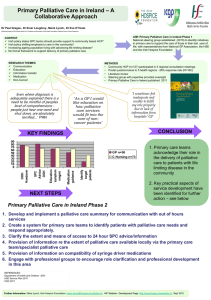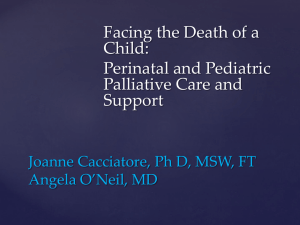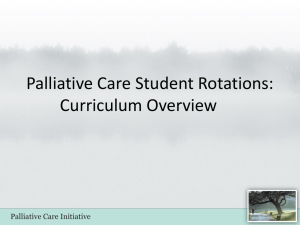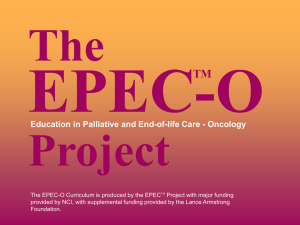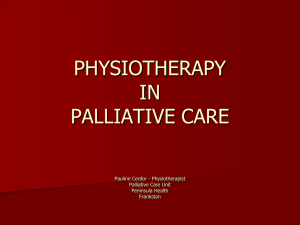HOPC Occupational Therapy Conference November 21st 2014
advertisement
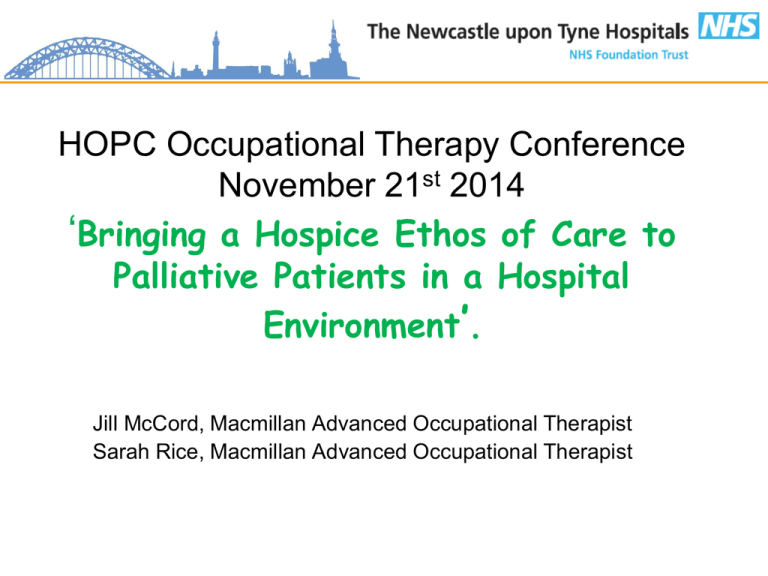
HOPC Occupational Therapy Conference November 21st 2014 ‘Bringing a Hospice Ethos of Care to Palliative Patients in a Hospital Environment’. Jill McCord, Macmillan Advanced Occupational Therapist Sarah Rice, Macmillan Advanced Occupational Therapist Introduction • • • • • • • History of NUTH AHP Macmillan Project Who we are and what we do Our Interventions Measuring our Impact Case Studies What Next?... Patient Feedback The AHP Palliative Care Project 4 year project funded by Macmillan - Oct 2012 to Oct 2015: • Aim to evaluate the benefits of having AHPs in a specialist palliative care team (SPCT) • Bring holistic/hospice care ethos to therapy in the acute care setting Freeman Hospital: 1 Full Time Physiotherapist 1 Part Time Occupational Therapist 1 Part Time Rehabilitation Assistant Royal Victoria Infirmary: 1 Full Time Physiotherapist 1 Full Time Occupational Therapist. Local & National Drivers Locally Recognition of gaps in service provision and difficulties in prioritising palliative type interventions by therapy staff in an acute setting 1 year Pilot project results formed the basis of the successful business case put forward to Macmillan NICE Supportive and Palliative Care Guidelines (1) promote a multi disciplinary approach to care to and recommend that comprehensive rehabilitation services should be available in all care locations National End of Life Care Strategy (2) further developed this emphasising the need for: • • • AHPs in Specialist Palliative Care Team Project the same high standards of care to be available to all people at the end of life, a skilled and specialised palliative care workforce to be available in all settings continuous improvements in the quality of care – particularly acute service care. All of this is underpinned in the strategy by a need to measure the outcome of palliative care interventions Who do we treat? People with:• Anxiety/ Distress • Pain – Including ‘Total Pain’ • Fatigue • Breathlessness • Weakness • Functional Problems (in addition to ward AHPs) • Confidence What do we add? Specific OT interventions: • Anxiety management/ CBT • Fatigue management • Hypnotherapy • Life story work, memory boxes • Confidence building • Purposeful activity • Complex/specialist equipment needs Educational and advisory role to ward therapists. Registered Visually Impaired COPD Margaret Decision to stop dialysis For End of Life Care Measuring Our Impact We selected 4 Outcome Measures: • PaCA) Palliative Care Assessment score (3) This rates symptom burden for specific individual service user symptoms. • (TOMs) Therapy Outcome Measures (4) This uses the framework of the international classification of functioning (ICF). It has had validity and reliability well demonstrated. • (EFAT) Edmonton Functional Assessment (5) Was used in the pilot study. It is again valid and reliable and gives a broad reflection of function. • (POS) Palliative care Outcome Scale (6) Once again validity and reliability have been demonstrated for this measure. TOMS • Suggests that: – We can help improve a patients situation to enable them get home even when overall condition may be deteriorating. – We can help make improvements in quality of life – Patients value our input Young lady Pain Cachexia Breathlessness Referral for Symptom Management Low Mood Nausea Leanne Vomiting Fatigue Anxiety Frequent admissions Cystic Fibrosis OT interventions: - rapport building – interests/roles; goal setting and purposeful activity; home assessment visit; fatigue management; anxiety management – CBT approach “Rehabilitation brings added value to supportive and palliative care… and is not an optional extra.” NCAT 2013 What Next?... • Business Case/ Commissioning • Awards/ Raising profile • OT Msc Project “You’ve really helped us (me) with everything. More than anyone else, I couldn’t have asked for more. You’ve taught me how to breathe properly and that. The other one’s came and taught me how to clear my chest but then they couldn’t come back to see how I got on, I didn’t like that. And they just wanted to see me walk. You came and talked with “The difference was that you were able to spend the time explaining things to me, explaining why my body felt the way it did, and talking me through what I needed to do to get back on my feet. You were also a friend when I needed to talk, and you actually listened.” me too, that has helped the most. You’re well worth your money, aye!” “Just two say thank you four help and support, if it wasn’t four your support I would probly still be in hospital, so many thanks.” “You made my life better, don’t know what I would do without your help recently.” “I had given up until you became involved - I had lost hope” “You’ve bent over backwards to help with everything, thank you.” (Patient’s Husband) “His wife asked me to pass on their thanks. Without your help and the things you taught him, he couldn’t have stayed at home with his family at the end, which is what he wanted.” (OT assistant) “The continuity made a difference, when I moved somewhere new you already knew me, you didn’t have to go away and check things. It was comforting to know that wherever I went there would be people coming to see me who knew me and what had gone on. And the encouragement you gave was great, it kept me going. I can’t thank you enough, you’ve both (SPCT PT & OT) been a brilliant help.” References • Improving Supportive and Palliative Care for Patients with Cancer (2004) NICE. • End of Life Care Strategy – promoting high quality care for all adults at the end of life (2008) DH. • The Edmonton Functional Assessment Tool: Further Development and Validation for Use in Palliative Care, Kaasa, T., Wessel, J. 2001, Journal of Palliative Care 17, 1, 5-11. • Therapy Outcome Measures for Rehabilitation Professionals: Speech and Language Therapy, Physiotherapy, Occupational Therapy. Enderby, P., John, A., Petheram, B. 2nd Ed, John Wiley and Sons Ltd. 2006. • A User’s Guide to the Palliative care Outcome Scale, Aspinal, F et al (2002), King’s College London. • Monitoring a hospital palliative care team using the PaCA tool, Regnard, C et al; European Journal of Palliative Care, 2005;

